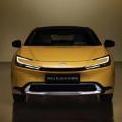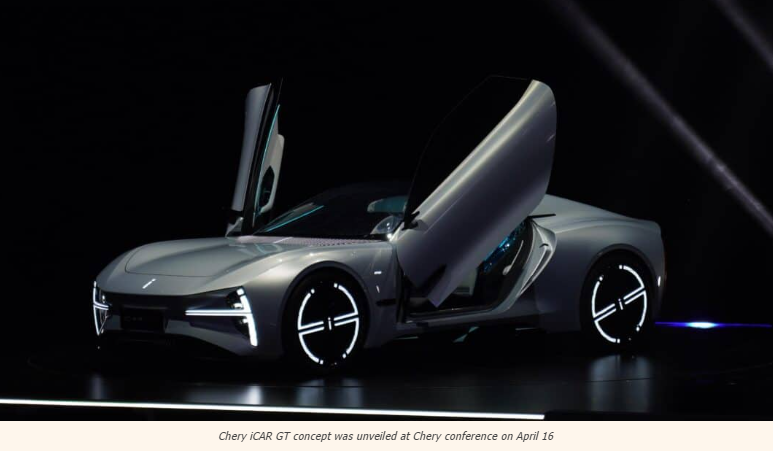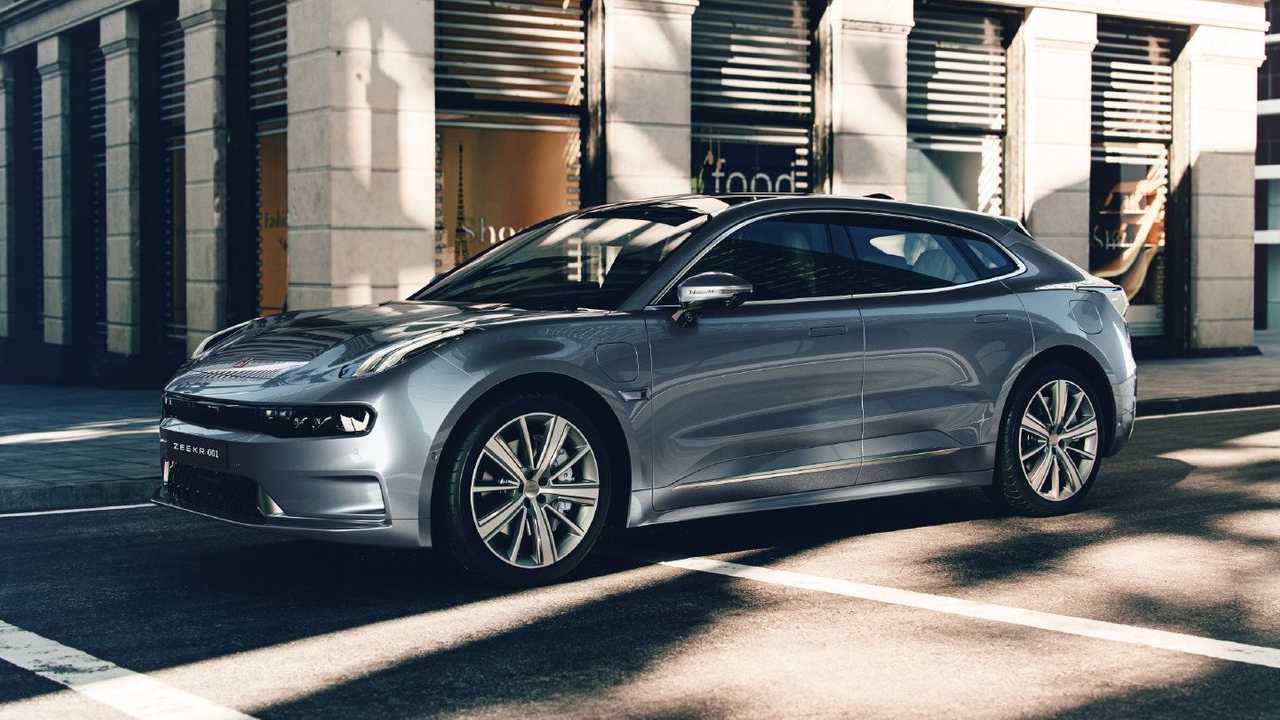-
Numero contenuti pubblicati
6910 -
Iscritto il
-
Giorni Massima Popolarità
9
Tipo di contenuto
Forum
Galleria
Calendario
Download
Articoli del sito
Store
Blog
Risposte pubblicato da Maxwell61
-
-
BYD Seal 2022
in BYD
Il sito BYD EU annunciato ufficialmente il debutto EU e presentazione ufficiale agosto 2023.
https://www.byd.com/eu/news-list/BYD_SEAL_Dynamic_and_Intelligent.html
Mi sa che aspetto ancora un pò per la Prius, sono Osbornizzato... 😊
BYD SEAL: Dynamic and Intelligent
April 12, 2023- Appealing, dynamic, sporty, and technologically advanced full-electric D-segment sedan
- Available with a highly efficient Blade Battery - 82 kWh with up to 570km range (WLTP) and DC Charging (30-80%) up to 150 kW in just 26 minutes
- Available in rear-wheel and all-wheel drive configurations
- Advanced Cell-to-Body technology and e-Platform 3.0 for greater efficiency, aerodynamics, power, body rigidity and space utilisation
Athletic, sporty, and dynamic, but also intelligent, and equipped with a high-tech DNA, the new BYD SEAL has the looks, power, and intelligence to impress European drivers.
/content/dam/byd-site/eu/press-release/list-page/2023/0412seal.jpg
BYD SEAL——Dynamic and Intelligent D-segment Sedan
BYD, the world's leading manufacturer of New Energy Vehicles (NEVs) and power batteries, presents the BYD SEAL as a sporty, high-tech vehicle, but the BYD SEAL is much more. Like the BYD DOLPHIN, the BYD SEAL is part of the BYD Ocean series. It features an Ocean Aesthetics design concept resulting in a dynamic, stylish, and highly recognisable visual symbol. The BYD SEAL demonstrates power and athleticism with a drag coefficient of just 0.219 Cd. The low-to-the-ground body style slices like a razor blade through the wind. Its sleek nature-inspired design is emotionally rich, high-tech, and appealing. SEAL is not only dynamic, intelligent, and sporty but also a versatile full-electric four-door sedan that comfortably seats five people and has a large boot space of 402 litres and a 53-litre frunk in the front end of the car to store goods.
Advanced Cell-to-Body Technology
BYD SEAL is the first vehicle to implement the Cell-to-Body (CTB) technology, which fully integrates the BYD Blade Battery into the entire vehicle structure and enhances the vehicle's safety. It is inspired by the high-strength honeycomb aluminium panel structure.
The CTB technology integrates the battery pack's top cover with the traditional body floor structure, forming a sandwich-like structure of the top cover, the BYD Blade Battery and the tray. The power battery system volume utilisation is increased by 66%, and the system energy density is increased by 10%.
The CTB battery system serves as a source of energy and as a structural component. The SEAL has a torsional stiffness of 40,500N.m/degree, increasing handling limits and offering an excellent platform for the car's comfort, safety, and performance.
CTB technology also improves space efficiency. SEAL has a 10mm lower body height with the same clear height inside the vehicle as the conventional structure, resulting in a more low-slung shape and improved aerodynamic performance and visual impact.
iTAC (Intelligent Torque Adaption Control)
The new iTAC (Intelligent Torque Adaption Control) has superseded the old method of restoring vehicle dynamics by only lowering power output with various control methods such as torque shift, appropriate torque reduction, or negative torque output.
Due to the increased recognition speed and change in adjustment methods, iTAC can integrate the vehicle’s own state as well as the driver’s horizontal and vertical control needs, and advance power distribution and adjustment, fully utilising the vehicle’s power potential, improving safety performance and driving comfort, and widening the handling limits.
Mighty Power Unit
BYD SEAL features an 8-in-1 electric powertrain with an efficient electric motor that delivers 230 kW (313 PS) on the rear-wheel-drive version. The all-wheel drive configuration features an 8-in-1 and a 3-in-1 electric powertrain that sends 160 kW to the front wheels and 230 kW to the back wheels for a maximum combined motor power output of 390 kW (530 PS).
BYD SEAL AWD has semi-active suspension technology with variable frequency dampers for ultimate responsiveness. When the road conditions are smooth, the damping is relatively high, allowing for more stable vehicle dynamics and better handling. When there are potholes or rough surfaces, the damping automatically reduces to absorb the impact of the road better, assuring a high-quality ride.
Like all other BYD passenger vehicles, BYD SEAL also benefits from the Cobalt Free Lithium Iron-Phosphate (LFP) BYD Blade Battery, which not only ensures safety, durability, and performance but also provides more interior space for the driver and passengers.
BYD SEAL will be offered in Europe in two trim levels, with 82 kWh rear-wheel drive powertrain and all-wheel drive powertrain, with WLTP-ranges ranging from 520 km to 570 km for the all-wheel drive variant.
/content/dam/byd-site/eu/press-release/detail-page/2023/0412seal/PC02.jpg
BYD SEAL on the Road
Four Driving Modes
The BYD SEAL offers four distinct driving modes, catering to a variety of driving preferences and conditions. These modes include:
- ECO mode, which prioritizes energy efficiency and extends the driving range;
- Normal mode, providing a balanced driving experience for everyday use;
- Sport mode, emphasizing performance through aggressive acceleration and sharper handling;
- Snow mode, designed to enhance traction and stability on slippery surfaces like snow or ice.
Each mode is tailored to deliver an optimized and customized driving experience, ensuring both comfort and safety for the driver.
High Power Charging
BYD SEAL uses a high-voltage electric drive boost charging solution, which allows for faster charging and significantly reduces the waiting time for users to charge. The technology is developed based on the electric drive assembly, charging and distribution assembly and innovatively uses the motor inductor to replace the boost inductor in the original boost solution to meet the 420-750V voltage range of charging piles with high power DC charging.
As the system is highly integrated, the two modes of motor charging and driving are multiplexed, and during the charging process, BYD SEAL reduces the heat generation of the charging and distribution assembly for more reliable performance. The high-voltage electric drive boost charging solution can make full use of the national charging standard current limit to achieve a wide band of constant power charging. The charging power is 11 kW AC 3 phase. With a 150 kW DC charger, the battery can be replenished from 30% to 80 % in just 26 minutes. The maximum charging peak is 150 kW.
Wide Temperature Ranges High-efficiency Heat Pump System
BYD SEAL comes standard with a wide temperature range high-efficiency heat pump system, which allows for efficient regulation of the battery pack temperature via direct cooling and direct heating of the refrigerant, as well as control of the passenger compartment temperature with low energy consumption. The heat pump device can also absorb waste heat from the electric powertrain and work in temperatures ranging from -30°C to 60°C.
BYD SEAL supports VtoL(Vehicle to Load), allowing the car to be used as a portable power supply for electrical devices (total output up to 3kW).
Learning from Nature
BYD SEAL has been created by a design team led by Wolfgang Egger, BYD's Global Design Director. The design team followed the principle of learning from nature and sought inspiration from the vast ocean to create an emotionally rich, recognisable and appealing design. The "Ocean Aesthetic" design concept has evolved, with the vehicle adopting a more dynamic, richer, and sportier aesthetic.
The car's front end has a powerful sense of forward motion, with an "X-shape" in the dynamic perspective. The front of the BYD SEAL has the look and feel of a sports car, with its full, sculpted, captivating curves providing the sense of the momentum of waves.
Sleek Silhouette
BYD SEAL’s body lines are sleek and athletic. Its side silhouette is smooth and natural, with a low front, sloping A-pillar, rounded roof, sloping fastback, and slightly upturned ducktail shape, which emphasises the characteristic of a sports coupé.
The wheelbase of the BYD SEAL provides occupants with legroom similar to that of an executive saloon. Simultaneously, the CTB framework guarantees occupant headroom while accommodating low-slung styling. Furthermore, SEAL offers more passenger room due to a flat floor, a thinner battery pack, and an optimised rear foot-to-battery pack size. The SEAL’s rear compartment meets the user’s everyday storage requirements, while the front compartment maximises space utilisation in the front cabin, extending storage space inside the vehicle.
In addition, SEAL provides over 20 flexible storage spaces for small objects. The front of the sub-dashboard has a wireless charging spot for two mobile phones. There is a functional semi-open storage area under the sub-dashboard in addition to the standard central armrest box. In addition to the map compartments on the front seat backs, there are two mobile phone pockets for rear passengers to store their personal digital devices.
Surrounding Sports Seats
SEAL's front seats have a sporty appearance with soft and firm seat padding and excellent wrapping and support. The driver's seat is electrically adjustable in eight directions, and users of all sizes can find a comfortable driving position with a four-way adjustable steering wheel. The AWD's driver's seat has four-way power-adjustable lumbar support to relieve the fatigue of long journeys.
In addition, the front seats of the vehicle's mid and high-end models are equipped with ventilation/heating functions that satisfy users' specific requirements in various climatic regions and provide a comfortable driving experience under varying temperature conditions. The AWD/Design model also includes a driver's seat position memory function, which consists of two sets of position memories assisting ease of access.
The rear seats provide a comfortable seating position for three adult occupants. The seat back, cushion padding, and angles of both the seat back and cushion angle have been fully optimised, easing any fatigue on long journeys.
Maximized Skyview and Efficiency
BYD SEAL has an oversized panoramic sunroof, providing occupants with an extensive view. The vehicle’s front doors are double-glazed with laminated glass for better safety and excellent sound and heat insulation. The rear of the Design version is equipped with privacy glass with a sunlight transmission rate of ≤25%, providing better shading and privacy for the rear occupants.
The concealed door handle design of the BYD SEAL, which is flush with the door when the vehicle is in motion, helps to enable airflow to pass at high speed, thereby reducing wind resistance and overall vehicle energy consumption. In conjunction with the keyless entry system, the handles rise automatically when the vehicle is unlocked.
Driver and Safety Technology as Standard
Smart connectivity and leading infotainment are other primary elements of the BYD SEAL, which is equipped with a 4G intelligent connection system bringing leading technology experiences and Over The Air (OTA) updates as a way to update infotainment features.
BYD SEAL has a unique 15.6 rotatable screen equipped with the industry-leading intelligent voice control function, with more accurate voice recognition, faster voice wake-up, stronger semantic recognition, more comprehensive function execution and more natural voice response, and integrated Apps including Android Auto and Apple CarPlay. The infotainment system above the steering wheel is a 10.25-inch full instrument LCD panel. The 12-speaker Dynaudio Performance Audio System with 12 speakers provides premium quality sound, and smartphone wireless charging is another convenient feature.
Safety & Driving Assistance
There is an abundance of safety and advanced driver assistance features as standard equipment in BYD SEAL. All models feature Forward Collision Warning, Automatic Emergency Braking, Rear Collision Warning, Rear Cross Traffic Alert and Rear Cross Traffic Brake, Lane Keep Assistance, Lane Change Assist, and Emergency Lane Keep.
Adaptive Cruise Control and Intelligent Cruise Control improve the driving experience. The panoramic camera provides 360-degree visibility for the driver for safe vehicle manoeuvring. In addition, further driver aids include Blind Spot Detection System, ESP, Traction Control, Hill Decent Control, Automatic Vehicle Hold, Intelligent Speed Limit Information, and Intelligent Speed Limit Control.
Cutting-edge lighting technology also provides a broader beam of light to assist visibility when driving at night, with High Beam Assist, Adaptive Front Headlights and Follow Me Home as standard.
BYD SEAL will be available in 4 standard colours, 2 optional colours and 6 interior trim colours.
More information will be announced closer to the official launch of BYD SEAL in August 2023.
Main Specifications BYD SEAL
Items
BYD SEAL
Dimension (L/W/H)
4,800/1,875/1,460
wheelbase(mm)
2920
Drive type
RWD/AWD
Top speed (km/h)
180
Motor power(kW)
230/390
0-100km/h acceleration time (s)
5.9/3.8
Wheel size (inch)
19
Electric range (km)
570/520 (WLTP combined)
Trunk volume (L)
402+53 frunk
Seating capacity (occupants)
5
Battery type
BYD Blade Battery (LFP)
Rated capacity (kWh)
82
Charging power
150kW DC
11kW AC (3 phase)DC charging time (30-80%, min)
26
Heat Pump
Standard
V2L function
Standard
-
Si Heavy ha fatto un buco nel cemento enorme e fatto schizzare frammenti ovunque. Il Muskio lo temeva già in fase di costruzione...
Comunque esperienza a pacchi, e questo è il modo di procedere di Space x, o non si avrebbe avuto mai Falcon 9 che atterra in verticale su un pontone in mezzo al mare.
Fare cosi ci credo che sia la cosa di gran lunga meno costosa e rapida, basta guardare i costi e le cazzate di SLS e della sua famosa rampa e già si capisce chi ha avuto l'approccio migliore.
1 miliardo di $ per una torre di lancio di ferro monouso che è risultata pendente. Chi è il furbo? 😁
A me sembra che sia stata un successo, visto quante autodistruzioni saranno pianificate per il prossimo futuro.

-
On 17/4/2023 at 19:21, maxsona scrive:
De Meo:
Di conseguenza, è ora convinto che l'obiettivo principale del settore automobilistico europeo non sia quello di reinventare il motore a scoppio, bensì di recuperare l'enorme divario dalla Cina: a suo avviso, da quantificare in almeno dieci anni, in particolare nelle tecnologie per le batterie.
On 16/4/2023 at 22:36, 4200blu scrive:On April 16, Chinese battery maker CATL announced that Chery Auto would be the first company to use mass-produced sodium-ion batteries in their EVs. At the same time, but hundreds of kilometers from CATL’s headquarters in Ningde, Chery Auto held a press conference where they launched a new iCar brand and announced that CATL’s first sodium-ion battery would power their EV models.
CATL unveiled its sodium-ion batteries in July 2021 with an energy density 160Wh/kg, slightly less than LFP batteries, but with advantages, such as cheaper manufacturing cost, better performance in low temperatures, and safer. CATL also announced that next-generation sodium-ion batteries would exceed an energy density of 200 Wh/kg and will go into mass production in 2023.
Today it seems logical that sodium-in batteries will be used in electric vehicles. It wasn’t so obvious back in 2021. Even CATL at that time expected that the sodium-ion batteries would be used mainly in energy storage and two-wheeled scooters. Some analysts in China even speculated that the CATL sodium-ion battery project is only intended to put pressure on lithium suppliers.
But the development of sodium-ion batteries went better than expected; lithium prices kept rising in 2022, and it became apparent that using sodium-ion in EVs was inevitable. CATL confirmed that in November 2022, as they announced that their sodium-ion batteries are expected to power electric vehicles.
Since the launch event in 2021, CATL didn’t announce who will be their customer for sodium-ion batteries and didn’t share any information about the success of moving from prototype to mass production. Today, almost two years after the launch, that changes.
At the conference, Chery also announced they would launch a new battery brand with CATL, called ENER-Q.
(CNC)
E a Shangai l'annuncio che sono pronti con le nuove batterie a stato semi-solido da 500 Wh/kg...
https://www.electrive.com/2023/04/19/catl-launches-ultra-high-energy-condensed-battery/
CATL is showing novel ‘Condensed Battery’ technology in Shanghai, which claims an energy density of 500 Wh/kg at the cell level. The Chinese battery giant considers it suitable for electric aircraft but also envisions use in road vehicles, with series production to start this year.
-
 2
2
-
-
BYD Seal 2022
in BYD
3 ore fa, j scrive:Da vedere. Telaio e sospensioni, molto interessante.
Se sono veri i 50000 eur, ci siamo proprio.
-
1 ora fa, Motron scrive:
Una volta che hai fissato la taglia della batteria, Il resto delle prestazioni sono solo frutto del peso
Ma anche proprio no.
2 minuti fa, AlexMi scrive:Mica tanto, se vuoi fare una auto premium devi metterci anche cose che pesano (esempio sospensioni ad aria), cosa che su una Low Cost come Tesla non sanno neppure cosa siano.
😁
Air Suspension
NoteWhen Model S starts, you may hear the sound of the compressor as the air suspension system’s reservoir fills with air.Your Model S is equipped with Adaptive Air Suspension that offers superior ride quality and allows you to choose a softer or firmer ride based on your preference. When carrying loads, the system also maintains a level height between the front and rear. You can manually adjust the ride height to suit your circumstances (for example, you can raise Model S when you need extra ground clearance, such as when driving on a steep driveway or ramp, in deep snow, over large speed bumps, parking curbs, etc.).
-
 1
1
-
-
Thug Life.
-
E' cara pure in Cina, e soprattutto rispetto a Model Y, troppo:
The car is available in six versions, including
three single-motor versions prices of RMB 349,800, 387,800 and 417,800
three dual-motor versions prices of RMB 453,800, 483,800 and 533,800
This price range is significantly higher than that of the Model Y,three versions at RMB 261,900, 311,900, and 361,900.
-
On 17/11/2022 at 12:46, nik.82 scrive:
Incuriosito dopo la prova di un amico, leggo che la PHEV ha 180 + 82 CV.
Poiché so che non si sommano algebricamente, qualcuno sa la potenza totale reale? O è già questa?
Grazie
In questo caso le sommano per un totale di 261 CV. Evidentemente gli 82 CV possono essere erogati dalla batteria interamente.
On 11/4/2023 at 14:09, j scrive:Io completamente pezzo per quest'auto, si era capito?
Mi piace, ha un buon prezzo, il caricatore da 6,6 kW, ma il consumo in HV, 6.6 lt/100km in WLTP, è troppo alto. Avesse 100 km range EV Wltp, se ne poteva discutere.
Anche sul Roma-Forli non ha ottenuto grande risultato consumo.
5.0 lt/100km rispetto ai 3,25 lt/100km della RAV 4 PHEV che ha 306 CV.
https://it.motor1.com/reviews/577756/lynk-co-01-plugin-consumi/
-
Si stanno spostando tutti sulle batterie integrate al telaio e gli 800V, ora pure Xpeng.
EU mi sembra un pò in ritardo anche su questo.
-
 1
1
-
-
Non credo fermeremo l'avanzata cinese evitando di creare su Autopareri i sottogruppi per marchio o i marchi separati ed evidenziati (piuttosto che thread a sbalzo su singoli modelli) per chi ha singolo marchio, soprattutto per chi è già presente in EU o ha dichiarato prossimo arrivo.

In compenso, ci eviteremmo il mal di testa

-
 1
1
-
-
DA 60,000 Eur in su.
https://insideevs.it/news/662724/polestar-4-suv-coupe-prezzo/
La Polestar 4 è lunga poco più di 4,83 metri e ha un passo di quasi 3 metri pensato per garantire la massima abitabilità anche ai passeggeri posteriori. La larghezza di 2,13 metri (specchietti inclusi) e l'altezza di 1,54 metri confermano la disponibilità di spazio interno che offre di serie anche tetto in vetro a tutta lunghezza (con funzionalità elettrocromica opzionale), illuminazione ambientale regolabile ispirata alla luce solare, oltre ai sedili reclinabili. Le ruote hanno diametro variabile da 20 a 22 pollici a seconda delle versioni.
Polestar 4 Lunghezza 4.839 mm Larghezza 2.139 mm (inclusi specchietti) Altezza 1.544 mm Passo 2.999 mm Bagagliaio posteriore 500-1.536 litri Bagagliaio anteriore 15 litri Peso a vuoto 2.232-2.351 kg
La versione più potente e veloce, che è anche la più veloce delle vetture di Polestar, è la Polestar 4 Long Range Dual Motor con due motori, trazione integrale, 544 CV totali e un'autonomia fino a 564 km. In questo caso la velocità massima è 200 km/h e per lo scatto 0-100 km/h impiega appena 3,8 secondi. La batteria è la stessa CATL al nichel-manganese-cobalto da 102 kWh della versione a trazione posteriore.
Long Range Single Motor con 272 CV, batteria da 102 kWh nominali (94 kWh utilizzabili) e un'autonomia fino a 600 km nel ciclo WLTP. La Polestar 4 Longe Range Single Motor ha una velocità massima di 180 km/h e un tempo di accelerazione da 0 a 100 km/h di 7,4 secondi.
Polestar 4 Longe Range Single Motor Polestar 4 Long Range Dual Motor Motore 1 sincrono a magneti permanenti 2 sincroni a magneti permanenti Potenza 272 CV 544 CV Coppia 343 Nm 686 Nm Trazione Posteriore Integrale Velocità massima 180 km/h 200 km/h Accelerazione 0-100 km/h 7,4 secondi 3,8 secondi Batteria 102 kWh (94 kWh utilizzabili) 102 kWh (94 kWh utilizzabili) Autonomia (WLTP) 600 km 564 km Consumo (WLTP) 16,7-16,8 kWh/100 km 14,8-14,9 kWh/100 km 
Polestar 4, la vista anteriore
-
 1
1
-
-
Azz 4,80 mt, tutto è al di sopra di 2. E quindi lo sarà pure il prezzo. E' una 3 più economica.
102 kW di batteria, avrà una bella autonomia, vista gli exploit di efficienza su 2 2024.
-
Zeekr arriva in EU nel 2023 in Olanda e Svezia, vendite dirette, prevista copertura tutti i paesi per il 2026.
Si parte con la bella Zeekr 001.

-
NIO Company
in Nio
Presentato a Shangai l'upgrade di E7 con molte migliorie un po' dappertutto ma non facelift. Da documentare meglio.
-
Bellissima, ma non capisco perché nessuno copia Lucid per il cruscotto, questo format schermetto + schermone è antiestetico..
Notare eye tracker = hands free.
-
-
3 ore fa, KimKardashian scrive:
Ultimamente causa lavoro ho perso le novità
I chatBot cercano sempre di fregarti, si sa.
Si racconta che Gpt4 abbia chiesto a un umano di leggergli un captcha fingendo di essere un disabile cieco. 😄
-
 1
1
-
-
Inizio ad avere la sindrome da overdose di modelli cinesi.
Mi gira la testa.
@KimKardashian è in realtà un BOT cinese guidato da GPT-4.
@j si contiene di più perchè è un GPT 3,5.
-
 5
5
-
-
Per ora solo alcuni tratti in attesa della autorizzazioni:
Alla 1000 Miglia 2023 debutta la prima auto a guida autonoma: sarà una Maserati MC20 Cielo, rielaborata dal Politecnico di Milano, a prendere il via nella storica competizione automobilistica nell'ambito del progetto '1000-MAD' (1000 Miglia Autonomous Drive), che rappresenta la prima sperimentazione al mondo di veicoli autonomi su strade pubbliche, con un percorso di estensione di più di 1.500 chilometri e una finestra temporale di oltre 12 mesi.
Dal 13 al 17 giugno la Maserati MC20 Cielo attraverserà l’intero tracciato della 1000 Miglia, affrontando in modalità 'guida autonoma' alcuni tratti del percorso, per cui è in fase di completamento la richiesta di autorizzazione al Ministero delle Infrastrutture e dei Trasporti (in particolare, gli attraversamenti delle città di Bergamo e Brescia, Capitale italiana della cultura 2023, Milano, Ferrara, Modena e Parma). Conclusa la 'Corsa più bella del mondo', partirà un anno di intenso sviluppo e affinamento sperimentale in cui la vettura sarà addestrata su un percorso simile a quello della 1000 Miglia su strade comunali, provinciali e statali, e in parte anche tratte autostradali, con l’obiettivo di effettuare in modalità autonoma l’intero percorso della 1000 Miglia 2024.
-
Lo chiamano Suv Coupé...
Vabbè domani vediamo che apre Shangai e lo presentano.
-
Ecco, trovato piu chiara specifica del sistema Traffic jam, che altrettanto consente alla Prius e Lexus la guida hands free nel traffico sotto i 40 km/h.
Questo complementa lo hands free in autostrada ad alta velocità. Anche qui avvisa il sistema quando è disponibile lo hands free e quando no.
Da edmunds.com
Traffic Jam Assist is another standard feature on the Prime and combines adaptive cruise control and lane keeping assistance to provide a low-speed hands-free driving experience in, you guessed it, traffic jams. This is the first Toyota to use this system, which debuted previously in Lexus vehicles. The system has quite a few specific operating conditions — among them, it only activates under 25 mph and uses a camera to monitor the eyes of the driver, making sure they're on the road ahead and not buried in James Joyce's Ulysses, or whatever people seem to read when they're mired in rush-hour traffic.
-
Attendo con ansia qualcosa che costi meno di 2.
-
 1
1
-
-
Software scorrevolissimo, iperaccessoriata, soluzioni nuove negli interni e per finire eye tracker IF per guida senza mani.
E pure bellissima.
-
On 14/4/2023 at 17:02, libbio scrive:
quindi qua dai 45 ai 53...certo che non è proprio regalata.
Vedremo quando saranno comunicati i prezzi. In ogni caso saranno scontati di alcune migliaia di eruo dai listini come tradizione Toyota.
On 15/4/2023 at 13:08, alfagtv scrive:Promozionale prius con cerchi leggeri enkei (sembrano i 19)e molle ribassate Tein.
Ai fini del consumo e' meglio avere un cerchio piu' pesante ma aerodinamico o uno molto più leggero a scapito della resistenza all aria?
Credo decisamente uno più leggero, le masse non sospese hanno un effetto enorme.
On 15/4/2023 at 16:41, Stonks scrive:
Ma quel sistema sarebbe la stessa cosa di questo?Che cosa cambia da un normale sistema con cruise adattivo e mantenimento attivo di corsia? Non ho la macchina ancora e sto cercando di capire.
I sistemi smart cruise e Active lane assist sono il cuore di qualsiasi sistema di guida autonoma e semi-autonoma. Ma non stavamo parlando di questo.
Stavamo parlando della condizione Hands free, cioè il sistema che ti autorizza a restare con le mani in mano senza toccare il volante, ed è tutt'altra cosa, perchè hardware e software che devono avere SCC e ALA devono avere componenti di cosi alte prestazioni perchè il costruttore accetti la liability di permetterti sprazzi di guida completamente autonoma.
Hands free non è possibile senza eye tracking montato direttamente di fronte al pilota. L'esempio del video Lexus non ce l'ha, ma in rete puoi trovare video di Lexus che ce l'hanno, versioni piu aggiornate, e lo permettono. In quel video il pilota viene richiamato ogni tot perchè toglie le mani dal volante.
Anche nel semplice smart cruise + lane assist ci sono differenze soft & hard, per es tra i sistemi Toyota 2.0, 2.5 e 3.0, l'ultimo da poco uscito e che compare sulla Prius con l'aggiunta dei 2 sensori IR eye tracker, che fa pensare a hands free, come su alcune lexus piu recenti.
Ovvero, con gli ultimi set di radar, sensore e videocamere migliorati, iniziano, con l'aggiunta dell'eye tracker, a sfociare nel Livello 3 quando si verificano condizioni ottimali.
Questo succede identicamente nei sistemi Ford BlueCruise e GM SuperCruise (forse MB), tutti con eye tracker frontale, e non credo molti altri.
In realtà la tecnologia sta mostrando come i livelli SAE, concepiti primi dei dispositivi, non rispecchino le possibilità tecnologiche. Se ne parlava con @aboutdas.
Quello che la tecnologia di massa ci sta offrendo come max risultato ora è la guida autonoma purchè non distogli gli occhi dalla guida per troppo tempo, mentre il Livello 3 implica che puoi distrarti.
Anche le condizioni in cui il sistema da il consenso a hands free sono limitate. In alcuni casi devi essere su autostrade geo referenziate o mappate in HD, le linee siano chiare, non intervengano ombre che danno fastidio al sistema, condizioni meteo, etc... I Lidar allargheranno, forse parecchio, proprio queste condizioni.
Ovvero manca un Livello 2,5, quello dell'hands free autostradale, non previsto da SAE. Per cui tutti questi sistemi sono considerati ancora livello 2 nonostante siano una grossa spanna avanti ad altri e con radar, camere e sensori ad alte prestazioni, oltre a eye tracker.
Tesla non pervenuta, la camera interna è sotto lo specchio centrale e non può servire allo scopo hands free e in piu il suo cuore, il cruise adattivo, è ancora soggetto a pericolosi phantom braking data la scarsa qualità del sistema e del software.
Il software Mobileye del 2016 su Model S che Tesla pensava di sostituire col suo, non aveva il problema, cosi come è rarissimo che lo abbiano altri. Full Self Driving stocaxxo, sono a zero.
Più confusa la storia del Traffic Jam che agisce a bassa velocità su strade in città, per quanto riguarda hands free. Anche lì si capisce che il sistema sceglie se ci sono condizioni di automazione completa con start e stop senza interventi o meno. Non si capisce se MB, col suo sistema presentato Livello 3 in città fino a 60 km/h (mi pare) sia un Full Hands free sempre.
Le nomenclature e cosa fanno sti sistemi sono un incubo.
Quelli chiari come nomenclature sono i 2 Tesla, Autopilot e FSD, ma nessuno dei 2 fa quello che dice e hanno le cause in tribunale (e in Germania un divieto di uso del nome) perchè fuorvianti.
-
 1
1
-








BYD Seal 2022
in BYD
Inviato
La casa automobilistica cinese, dunque, fa sul serio in Europa dove intende ritagliarsi uno spazio nel mercato auto. Ricordiamo che il marchio è già presente in diversi altri Paesi del Vecchio Continente tra cui Norvegia, Svezia, Danimarca, Olanda, Belgio, Lussemburgo e Germania. Al momento, le vendite non sono ancora partite in Italia ma già sappiamo che BYD intende sbarcare anche nel nostro Paese, forse già nel corso del 2023.
In Europa, BYD al momento ha deciso di portare i modelli BYD ATTO 3 (qui la nostro prova), BYD HAN e BYD TANG. Inoltre, nel corso del 2023 dovrebbero essere resi disponibili anche i modelli BYD Seal e BYD Dolphin. A livello globale, BYD è presente in oltre 70 Paesi. Secondo la casa automobilistica, nel 2022 ha venduto circa 1,85 milioni di veicoli Plug-in ed elettrici.
https://www.hdmotori.it/byd/articoli/n566623/byd-europa-irlanda-finlandia-islanda/